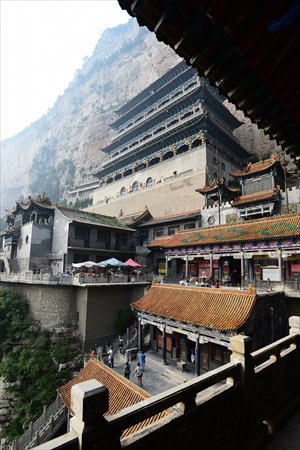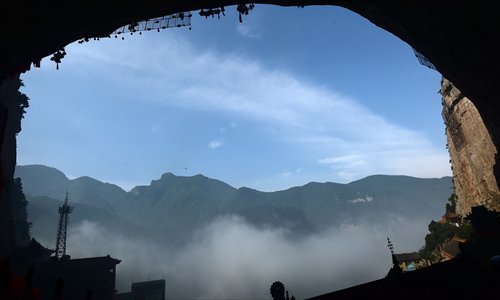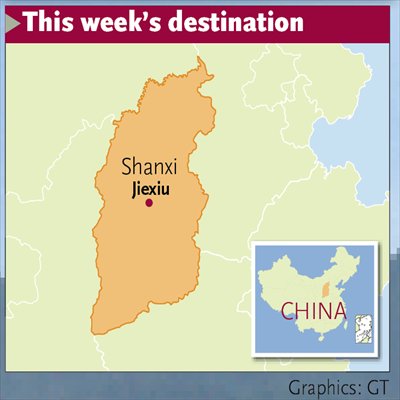Jiexiu: Doorway to the past
A look into the origins of China’s Qingming Festival

Temples built on the cliff of Mianshan Mountain Photo: CFP

A glimpse of the clouds from a cave on Mianshan Mountain on August 9 Photo: CFP

This week's destination
Many people working in China around this time are probably still struggling to nail down a destination for the upcoming three-day Qingming Festival holiday in early April. For those who are interested in Chinese history, but tired of widely visited cities such as Beijing, Xi'an and Nanjing, why not consider a trip that will delve into the origins of the festival itself?
So where do we start? Mianshan Mountain in Jiexiu, a county-level city in Central China's Shanxi Province.
For most travelers, Shanxi is more widely known for its pollution rather than its historic and scenic spots, and Jiexiu is probably the mostly forgotten place of all when it comes to famous places in the province.
However, you may have noticed that Shanxi has actually fallen off the list of most polluted places in China. In fact in 2014, the region enjoyed more blue sky days than Hebei and other provinces.
Jiexiu, 140 kilometers south of Shanxi's capital Taiyuan, was only connected to most provincial cities in China by high-speed train just two years ago.
Thousands of years of history and culture run through Jiexiu's alleys like underground rivers, and many of the historic sites there are largely untouched, well preserved and just waiting for curious explorers to find them.
Tragic ending, beautiful beginning
Before visiting Jiexiu you probably should learn a bit about the origin of the city's name.
It is named after Jie Zitui, an ancient official that lived during the Spring and Autumn Period (770BC-476BC). Famous for his loyalty, he once cut a piece of meat from his leg and secretly served it to his starving master, the exiled Prince Chong'er.
Later after Chong'er rose to become the Duke Wen of Jin, he attempted to find Jie to reward him with a position at court for his help. Jie, however, wanting to retire and leave court life behind refused and hid in the forests of Mianshan Mountain with his mother.
In an attempt to force Jie out from the forests, the Duke set fire to the mountain. The fire raged for three days, and Jie was finally found sitting under a tree, carrying his mother on his back. They had died trying to escape from the fire.
Deeply saddened by Jie's death, he ordered a temple built on the mountain as a memorial to Jie. Later the city at the foot of Mianshan became known as Jiexiu, which literally means Jie rests.
Maybe feeling guilty for burning his friend to death, the Duke also ordered that on the anniversary of Jie's death the use of fire would not be permitted for three days and people would have to eat their meals cold. This eventually became known as the Cold Food Festival and became a day of memorial for Jie and eventually people's ancestors.
Since this festival usually started a day before Qingming - one of the 24 solar terms that the Chinese use to divide the year - the Cold Food Festival and Qingming eventually became one festival during which Chinese would visit family tombs and remember their ancestors.
As a memorial day for Jie, for over 2,000 years in China, emperors from later dynasties made use of every nook and cranny of Mianshan Mountain cliff's to build and decorat various religious temples.
Now the mountain has emerged as a historical site possessing much cultural and religious significance. Since 2008, the Jiexiu government has held an annual Qingming cultural festival on the mountain every year in early April, where tourists from all over the world can enjoy watching traditional waist drum dancing and a reenactment of a traditional sacrificial ceremony.
Touch the religions in Mianshan
Walking the paths on the mountain you will be immediately overwhelmed by crisp, fresh air and striking colors. The green tall trees, dark yellow temples and bright red silks tied on the bells and along the iron chains on the cliffs form a sharp contrast in colors.
Meanwhile, the heavy copper bells with red silk tinkle and flutter in the wind, and the echoes of their sounds reverberate through the vast forest.
The mountain's peak is more than 2,500 meters above sea level which means you will find yourself standing above the clouds when you reach the top.
If you are lucky enough, you may run into some monks climbing down the cliffside using a safety harness and then stopping along the lower parts of the cliffs to hang the copper bells.
The monks have been doing this for over a thousand years, as people in ancient times believed that each tinkle of the bells in the wind would bring them luck and safety.
My tour guide said that in recent years, devout believers have had to pay nearly 1,000 yuan ($160) to have bells hung for them on the cliffs.
It's not all Buddhist temples on Mianshan, many Taoist temples can also be found along the mountain range.
If you have the energy I recommend using the iron chains to climb the cliffs to reach these temples. That's what people traditionally did when they wanted to pray or meditate at these temples. Judging from the vertical cliff and jagged rocky surface, Chinese back them must have been pretty good rock climbers. Don't worry though, if you're not an experienced rock climber, you can always take the nearby wooden stairs.
If you've been to Chinese temples before you're probably familiar with the statues you find situated here and there. However, Mianshan has a bit more than that. If you look carefully enough, you will spot the faded outer robes of a monk on some of the statues. Apparently, some of the statues in the temples are actually mummies.
There are a total of 88 temples on the mountain, but not every temple has mummies. So you need have real sharp eyes or you can just ask a tour guide.
Unlike Egyptian mummies, which have been moved to glass cases in museums all over the world, the mummies in the Buddhist temples in Mianshan are still in the meditation position they were in when they died, in some cases, over a thousand years ago.
It's said that these ancient Buddhists' dead bodies are well preserved because they only ate fruit and drank water from reputedly magic springs on Mianshan. According to legend, when they felt they were about to pass on they would first stop eating fruit and then stop drinking until death took them away. After they died, other monks would cover their dead bodies with clay to prevent them from decaying.
If there are not many visitors in the temples, the keeper may invite you to the ancient medication caves through an inconspicuous wooden door.
The door serves as a barrier between the dark temple and a bright hillside. There are four humble stone caves, each one around 1.5 meter wide.
Sitting in one of the caves with my eyes closed, I could picture how the ancient Buddhists must have meditated for days or weeks at a time while listening to the wind and birds chirping nearby.
If the temples on Mianshan Mountain cannot satisfy your curiosity, you can visit more down the mountain. Jiexiu has a total of 149 temples, including 77 Buddhist temples and 47 Taoist temples.
A pocket-sized ancient town
Apart from well-preserved religious temples, historical Jiexiu also hides a small town that combines residences, a military base, religious temples and factories all in one. Historians say that the town, Zhangbi Castle, is the only place of its kind in China that possessed both civil and military functions.
The town is 10 kilometers southeast of downtown Jiexiu, and visitors can either take a 20-minute taxi ride or take a bus to the castle from downtown.
Only 0.12 square kilometers in size, the castle assembles a variety of relics from over eight dynasties, reaching as far back as the Xia Dynasty (C.2070-C.1600 BC).
In addition to cultural relics from the Xia, it also has a military tunnel from the Sui (581-618) and Tang (618-907) dynasties, tombs from the Jin Dynasty (1115-1234), opera stages from the Yuan Dynasty (1279-1368), and many civilian courtyards built during the Ming (1368-1644) and Qing (1644-1911) dynasties.
Zhangbi Castle was a battlefield during the Sui and Tang dynasties, and enjoyed the geographical advantage of being surrounded on three sides by a ravine. The complicated 3,000-meter-long underground tunnel built during that time show's the castle's military importance.
A local villager surnamed Zhang showed me the way into the tunnel repeatedly telling me to follow him closely, as the tunnel extends in all directions and has many exits leading to the ground.
It takes 15 to 20 minutes to see all the military facilities. The temperature varies greatly in and out of the tunnel, and I could feel a raw wind seeping into my bones as I walked underground.
Outside the tunnel were some dilapidated courtyards and temples with faded blue glaze on top.
This antique town with its rich history, simple customs and very few outsiders would serve as a perfect weekend getaway for many people.
Rules of thumb
Tickets price: 110 yuan for Mianshan Mountain and 40 yuan for Zhangbi Castle.
Getting there: After taking a train to Jiexiu, take a bus from the downtown bus station to get to Mianshan Mountain. The trip takes about half an hour. There are many buses available every day, so there's no need to rush.
Where to stay: The hotels in downtown Jiexiu cost around 100 to 200 yuan per night. Hotels on Mianshan Mountain charge at least 300 yuan.
Advice: Remember to bargain with the taxi drivers because they never use meters. Normally it costs around 10 to 15 yuan for a 10-minute ride. There are no restaurants or hotels in Zhangbi Castle, so grab some food in downtown Jiexiu before visiting. If you are lucky, the villagers in Zhangbi may invite you for a homemade meal.